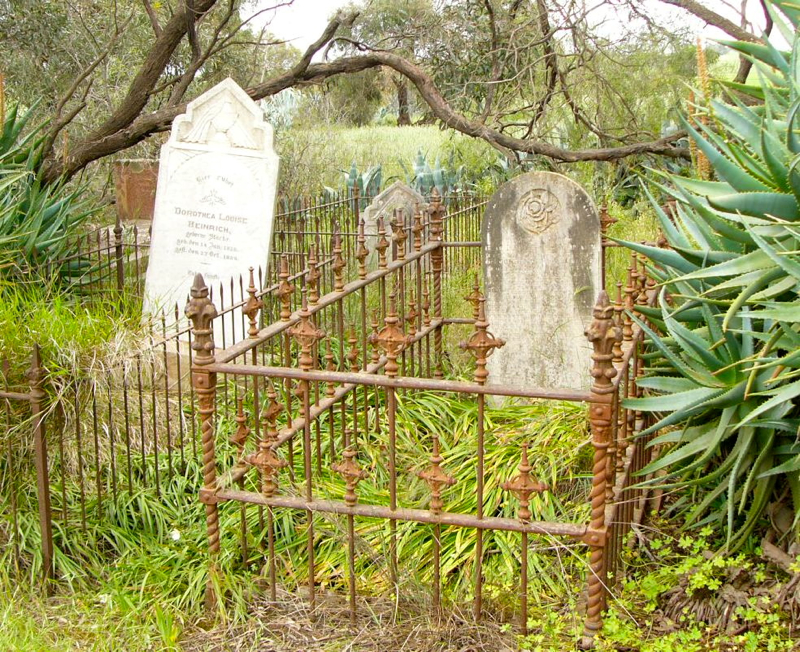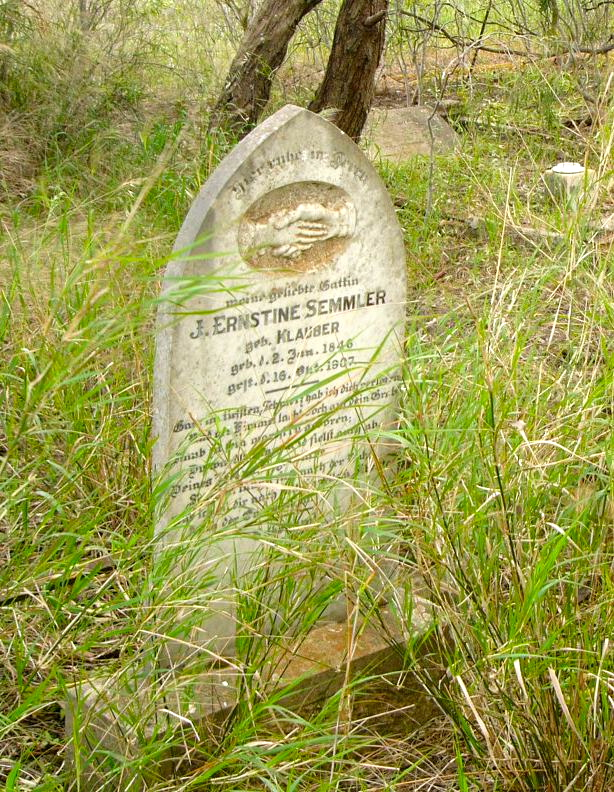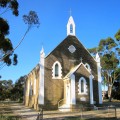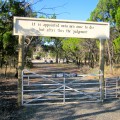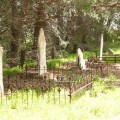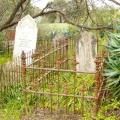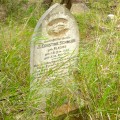Wend/Sorb Tour to SA’s Lower North
by John NoackThis article by John Noack is based on [1] the Tour Itinerary and Notes prepared by the Tour Organising Committee from information made available at the Lutheran Archives and on [2] published books relating to the History of Lutherans in Australia and listed under Sources. Photos contributed by John Noack and Eric Fiebig.
The annual South Australian Wend/Sorb Tour on Saturday 28 April 2012 brought to life some of the early country-located settlements of pioneers from various Germanic states, including Wends from Lusatia. It was clear that the early History of the Lutheran Church in South Australia could really be called the Histories of the various Lutheran Churches, Synods and Independent Congregations in South Australia. This became clear as the touring party in our fully-loaded bus, visited Buchsfelde, Magdala, Schoenfeld, Kapunda and Bethel and were informed in their tour notes about the Rosenthal (Rosedale) and New Mecklenburg settlements. There was both an ELSA and an ELSA aaG to differentiate, as well as various independent congregations which attached themselves to a particular Pastor. Variety here was clearly the spice of life!
Boarding the Woodside Coach
Our day began as Tour Participants boarded the Woodside Coaches bus at the western end of South Terrace in Adelaide, a location which allowed for all day free car parking for the participants. The Itinerary and the Tour Notes indicated that our country trip would be through Salisbury, Gawler and Kapunda and would include some less known former settlements in between. The Tour Notes compiled by the organisers and based on information both from the Lutheran Archives and from local sources such as the booklet about Bethel, promised to make some of these early Lutheran histories more comprehensible and clearer to all as the day progressed.
Buchsfelde becomes Loos
Our first visit on the Itinerary was Buchsfelde, which was located between Gawler and Two Wells. It was given this name by Otto and Richard Schomburgk, who had arrived in Adelaide on board the ship Princess Louise in 1849 and it involved about 22 families. These early settlers erected a church building in 1851 and this congregation was known as the German Evangelical Lutheran Church, an independent congregation. Otto Schomburgk was the pastor until he died in 1857. Dr Carl Muecke was the next pastor from 1855 to1868. In 1862, the wooden church was wrecked in a wind-storm but their cemetery on their church block survived and continued to function. It contains the grave of Otto Schomburgk and it was taken over by the local Council in June 1932.
A second Lutheran Church nearby was situated near the Gawler River on the Two Wells Road. It began in the home of an Independent Lutheran Pastor Julius Roediger. A new freestone church known as St Paul’s Lutheran Church was built here and was dedicated on 20 Dec 1863. A cemetery was also established on this block of land. Several other serving Pastors included Peter Hoefner from 1897 to 1900 and Philipp Scherer senior from 1900 to 1926. In 1910, this church joined the ELSA aaG (Evangelical Lutheran Synod of Australia on the old basis) and in 1926, joined the UELCA (United Evangelical Lutheran Church in Australia).
The local name Buchsfelde was changed during World War One to Loos. After 1927, St Paul’s merged with the Zion Lutheran congregation at North Gawler and in 1949, the St Paul’s church building was handed over to the Methodist Church. The inscriptions on the historic plaques set up here inform visitors that this was the location of the “Loos Methodist Church Roediger Memorial, founded in 1863” and that “St Paul’s church stood on this site, Independent Lutheran 1863-1949, Methodist 1949-1975”. The building was demolished in 1975.
Ridley’s Stripper at Wasleys
Following our exploration of early Australia’s rather complex Lutheranism, as displayed at Buchsfelde/Loos, we headed north from Gawler to the district around Wasleys. Here we were reminded of some of Australia’s agricultural history and inventions, where Mr Ridley in 1843 invented his crop stripper and in the 1860s, Charles Mullen developed a more efficient plough. Later, Richard Marshall cross-bred several strains of wheat to produce a red-rust resistant strain of wheat.
Also in this area north of Templers and south of Hamley Bridge was the settlement of Magdala, where the St John’s church, Wasleys and the cemetery were established. Early pastors included Dr C. Muecke until 1869; Pastor J Roediger from 1869 to1893; F. Rechner until 1906 and others. [Hebart 4(2) p.260] The earlier church building was also used as a school from 1870 to 1873 and from 1878 to 1892 and it was used for council meetings from 1870 to 1885. A new Magdala school was erected in 1903. It was later purchased by the community but sold in 1960, with the money being donated to the Hamley Bridge Hospital. A new church was dedicated on 4 September 1910.
The cemetery contains useful plaques, one of which indicates that Johan Christian arrived at Kangaroo Island on the ship Solway in 1837 and he died at Magdala in 1902. This plaque was erected by his descendants in April 1979 and it informs readers that Johan was certainly one of the very early pioneering immigrants in South Australia.
Schoenfeld’s Cactus Invasion
South of Kapunda is the Schoenfeld Cemetery. Its headstones, which were recorded in 1980 by Pastor P. A. Scherer, indicate that the pioneering Germanic families here included such surnames as Fluege, Gaertner, Haseloff, Heinrich, Menz, Semmler and Zilm. Although many enamel markers have been removed, the remaining headstones are well protected from visitors by large and very prickly cactus plants, so the pioneering residents here can be sure that they will continue to rest in peace!
Kapunda the Old Copper Town
Our lunch was provided for us at the St John’s Lutheran Church Hall at Kapunda. A glimpse into Kapunda’s history was provided by the local historian Ian Sarson. This included its well-known status as “an old copper town”, similar to nearby Ross’s Creek and Allen’s Creek. This area was good grazing country and was the location of the Koonunga station of Captain Charles Harvey Bagot, JP (1788-1880), a soldier, pastoralist and politician. [Weiss 4(3) p.88]
Early Lutheran church services were conducted by the Light’s Pass Pastor G. J. Rechner in the home of R. Hoffmann at Bagot’s Well. From 1897, the Nain Pastor A.P.T. Sabel conducted services in homes at Tarlee. As more Lutherans moved into the Kapunda district, the congregation was organized on 18 June 1907. The local Primitive Methodist chapel, once a busy spiritual centre for Welsh miners, was bought by St Paul’s and was renovated and dedicated on 8 March 1908. [Hebart 4(2) p. 260]
This St Paul’s congregation was part of the IS (Evangelical Lutheran Immanuel Synod) from early days to 1921 and was part of the UELCA (United Evangelical Lutheran Church in Australia) from 1921 to 1967. Some Moravian Brethren members of Bethelwho were living in Kapunda, joined St Paul’s congregation in 1928.
Kapunda’s Trinity Lutheran congregation was part of the ELSA/ELCA(Evangelical Lutheran Synod/Church of Australia) from 1915 to 1966 and was the centre of the parish from 1926 to1966. Their Pastors have included J. Georg, installed in 1915, C. Wiebusch, 1916, E. Fischer 1926, W. Koerber 1928, A. Schmidt 1969, W. Zanker 1978, L. Auricht 1979, R. Thiele, 1986 and K Woidt 1998. [Weiss p.89]
Since the church building was too small, in 1901, the larger Methodist church was exchanged for the smaller 1883-built Lutheran church with the payment of an additional 200 pounds. A list of early Lutheran elders includes H. Baehr, A. Beelitz, Beinke, E. Hanisch, H. Klau, A. Noll, C. Schaefer, G. Schuster, W. Seidel and A. Weckert. [Brauer 4(1) p.411].
In 1966, St Paul’s and Trinity combined to form the St John Congregation. Ian Sarson informed us that Kapunda has been a popular centre of parishes for other denominations but that now it is the parish centre only for the Lutherans. However, very good cooperation is still displayed in various district projects between all of the members of the various churches.
Bethel: its Moravian Brethren and its Lutherans
There was a lot to see and learn at the fascinating settlement and congregation at Bethel, located west of Kapunda. Its name Bethel in the Hebrew language means “House of God”.
Local historian Ron Schmidt, our very informative speaker in the church building, which is still labelled on the front wall the “Bruder Kirche” (Brother Church), drew our attention to their booklet published in 2007 titled “150th Anniversary of Worshipping God at Bethel”. The years 1857 to 2007 include Bethel’s early period as a Church of the Moravian Brethren and its post-1907 role as a Lutheran Church.
We were informed that its Moravian origins can be traced back to Jan Hus (1369-1415), who had been ordained as a Catholic priest but who was attracted to the ideas of the English religious reformer John Wycliffe. (Booklet 3(1) p.3) Refusing to withdraw his teachings when required by the Catholic Church, he was burned at the stake at Konstanz in 1415. His followers eventually found refuge in 1722 on the estate of Count Nikolaus Ludwig von Zinzendorf at Herrnhut in Germany.
These Moravian Brethren were evangelical and pietistic in attitude and were very mission-minded, both by practising mission-work and by supporting missions. Some members arrived in the mid 1850s and settled at first near Light Pass. Pastor C.S.D Schondorf was sent from Herrnhut to be their Pastor and he soon found and purchased some land west of Kapunda for his members. [3(1) p.4] The congregation was organized on 1 March 1857 and surnames of the foundation members included Arnold, Goedecke, Gruhl, Hombsch, John, Kirsch, Kornetzky and Linke. [Hebart 4(2) p.260]
The community of mixed farmers faced typical rural problems such as hot weather, lack of water, dust storm and fires, as well as some church-related problems, including the reluctance of Pastor Schondorf to retire when the new Pastor Jacobi arrived in 1876. Pastor Schondorf continued to live in his home at Bethel and to serve some of the locals. Complications also arose over land tenure and the related legal case in the High Court [3(1) p.39]. After Pastor Jacobi died in 1891, he was replaced by Pastor Paul Buck in 1892. In 1895, there were about forty families in the Bethel District [Weiss 4(3) p.26] so the present “Bruder Kirche” or Brother Church, which was built during 1895, has very secure foundations and is very solidly built, which should ensure that it will last for many years to come. When Pastor Buck eventually returned to Germany in 1907, no replacement for him was made [3(1) p.8].
Our speaker Ray Schmidt referred to their booklet’s 12 pages of honest memories and impressions, which were recalled and recorded back in 1962. During this Moravian Brethren period, black clothing was worn by the older women at all times and by all of the women when they attended church services (p.38). In the early days, the pews had no back rests so, in order to gain some ease, some members “leaned forward, resting their elbows on their knees and their heads on their hands”. [3(1) p.5 and Weiss 4(3) p.26] The Moravian ladies were required to wear communion caps called “Haube”, which the married women wore with blue ribbons and the unmarried women with pink ribbons. The Easter service before and during the rising of the sun and the special annual visit to the cemetery commemorating the members who had died during the previous year, both contributed to memorable celebrations at Easter and at other times. [3(1) p.36] Even some of the not so worthy habits of some of their pastors were recalled and recorded!
It was when Pastor Buck departed and returned to Germany that Bethel’s Lutheran period began on 21 March 1907. This congregation was faced with a smorgasbord of Lutheran Churches but (after maybe putting all of the names of the different groups of Lutherans in a hat!) it decided to join the IaaG (Immanuel Synode auf alter Grundlage or Immanuel Synod on the Old Basis). The Steinthal congregation, which was located 5 km away to the south-west and whose influential member Peter Doecke had died in 1906, then decided to join the Bethel congregation in 1910, especially after some of its members moved away to Cowell on Eyre’s Peninsula. (p.43)
Ray also referred us to their booklet’s 50 pages about Bethel’s various groups, activities and celebrations, which include its serving Pastors, [p.13] its School, [p.10] its Young People’s Society, its Brass Band, [p.15] a contemporary music band called “Spectrum”, [p.17] the Bethel Guild, [p.19] its Sunday School [p.22] and names of its foundation and recent members.
Absent from this booklet is any mention of the strong influence of some Cooneyites or followers of William Irvine on some of the Bethel members during the early 1900s and beyond. However, members who left the Bethel congregation naturally made no further contribution to its development and activities and present members would probably prefer that this episode is best forgotten, as was suggested in the response to a question about them! Those who are interested in the Cooneyites at Bethel can read their version of the story of their mission at Bethel on the following web address:
http://www.tellingthetruth.info/history_pioneering/australia-bethel.php
At the conclusion of this booklet, the genealogists should be pleased with the detailed cemetery plan of nearly 300 plots, which include the names, as well as the birth and death dates of those buried there. Our visit to the Bethel Cemetery, with its arches containing such biblical texts as “It is appointed unto men once to die and after this the Judgement” revealed to us the very plain and simple nature of the graves and head-stones. The booklet’s plan of Pastor Schondorf’s house and his brief biography also acknowledges the valuable work and record-keeping of this pioneering Moravian Pastor.
Clearly, Bethel’s two distinct Moravian Brethren and Lutheran stages are unusual, although a few other examples, such as Ebenezer in South Australia, may have also occurred. Clearly, our Tour Participants found these two stages most interesting in the context of Bethel’s pioneering history, settlement and development over 150 years from 1857 to 2007. Bethel’s informative booklet can be obtained from Mr Ron E. Schmidt, 83 Mildred St, Kapunda, S.A. 5373 at a cost of $15 or $19.20 posted.
Rosenthal or Rosedale
“Rosenthal” means “Rose Valley”, but since 1917, it has been named “Rosedale”. Unfortunately, it could not be visited on this Tour, because our bus was too heavy for an old and narrow bridge, even if all the passengers left the bus. However, we were able to read the detailed tour notes provided, in preparation for a future visit there.
On 8 December 1848, a group of Wends on the ship Alfred arrived at Port Adelaide and six families from this group, who were mostly of Wendish origin, settled at Rosenthal, which they called “Sachsenruhe” or Saxon Rest. The original applicants for land in this Hundred of Barossa and Shire of Adelaide were Andreas Albert, Andreas and Michael Deutscher, Johann Fleischer, Gottfried Liebe and Gotthelf, Karl and William Petschel. [Rosenthal plaque] They held their early worship services in Deutscher’s large family barn. In 1851, the ship Helene brought amongst its passengers, another group of Wends, who joined the Wendish families already at Rosenthal. These included the Burger, Hundrack, Mirtschin and Rentsch families.
A plaque indicates the location of the original Lutheran Church of Rosenthal, which is sometimes referred to as “the church of the sun-dried bricks”. It was built by Mason Gotthelf Petschel and his Carpenter brother Karl in 1852. It had a thatched roof and seated about 50 people. This church was dedicated by Pastor Meyer in April 1852 and was used until 1860.
A second church on the original property called the Johannes Evangelical Lutheran Church was dedicated in August 1866 by its founder Pastor Johann Heinrich Gustav Dost. This was one of South Australia’s Independent congregations. After the death of its founder Pastor Dost and in response to his wishes, both the church was demolished in 1929 and all of his church records were destroyed. [Weiss 4(3) p.148]
The Pioneer Cemetery is at the same location and includes the grave of the Medical Doctor Frederick Lampard, who travelled on foot to his patients who required assistance.
In Rosedale, St Martin’s Lutheran Church was founded in 1849 as a member of the Bethany-Lobethal Synod, which in 1855 became the ELSA (Evangelische Lutherische Synode Südaustraliens or Evangelical Lutheran Synod of South Australia). Its church building’s foundation stone was laid on 31 October 1859 and it was dedicated on 29 July 1860. [see Rosenthal plaque] Its bell tower carries its dedication date of 7 April 1910, with the text Psalm 90:17. Several pastors served for more than 40 years, including Pastor P.J. Oster from 1855 to 1897 and Pastor J.W. Georg from 1905 to 1956. Following the Lutheran Union, Rosedale’s St Martin’s and Gomersal’s Good Shepherd congregations, founded in 1850 and 1864 respectively, joined and became the Rosedale Trinity Congregation on 1 January 1970. [Weiss 4(3) p.148 and the Rosenthal plaque] A very detailed plaque at the Trinity church, with the heading “Rosenthal Lutheran Congregation, Sesquicentennial Memorial, 1850-2000. Founded 7 May 1850 by Rev Eduard Meyer”, provides a lot of useful information about this area’s early pioneering era.
“Kirche zum guten Hirten”, Neu Mecklenburg
In today’s English-speaking Australia, this heading means the “Church of the Good Shepherd” at Gomersal near Rosedale, which was founded in 1860 and which dedicated its first church on 20 November 1864. These Germanic immigrants were mostly from Mecklenburg and the church’s founding members included A. Becker; F. Bluecher; H.F., J.H & J.C. Dahlenburg; J. Koch; H. Loestrow; H. Lutze; C Gebert; C & H. Lienert; H. Marquart; C. Puettmann; F. Schmaal and E Wehr. [Hebart 4(2) p.259]
A Lutheran school was in operation here from 1864 to 1882 and the surnames of teachers included Buergy, Buchholz, Haseleg, Nadebaum, Pagenstecher and Tepper. Their second church was dedicated on 2 August 1925 and served the congregation until its merger with the Trinity congregation at Rosedale. A memorial cairn with plaques has been erected at the site of the church and cemetery to recall and remember its past.
Such Tours indicate the importance of such settlements for the early development of Australia and also the importance of collecting and preserving information from the past for future reference and enlightenment. Clearly, each early and later settlement has a varied and often complex history. Participants will be most grateful to the various organizers and researchers for this sort of fascinating adventure into the past. Such Tours provide food for thought about preserving this heritage, about making sure that it is stored safely in an Archive and that further lessons from such adventures can be gained in and for the future.
Sources of Information for this Report
1. Tour Notes, prepared by the Organising Committee using information made
available by the Lutheran Archives for the 2012 Wend/Sorb Tour
(1) Wend/Sorb Tour 28 April 2012, Lower North and Barossa. Itinerary and Travellers’ Notes.
2. Tour Notes prepared for the 2012 Rosenthal to Hamilton Wendish Wagon Trek
(1) Wagon Trekking: 3-6 May, 2012. Itinerary, Tour Notes and History by Helen Petschel and Christine Cook.
3. Bethel Booklet, referred to with page numbers in normal brackets ( )
(1) 150th Anniversary of Worshipping God at Bethel, 1857-2007 by the Bethel Congregation.
4. Books about Lutherans in Australia and referred to according to the Author
Brauer, Hebart or Weiss, with page numbers in square brackets [ ]
(1) Brauer, A. Under the Southern Cross (Lutheran Publishing House, Adelaide, 1965).
(2) Hebart, Th. The United Evangelical Lutheran Church in Australia (Lutheran Book
Depot, North Adelaide, 1938)
(3) Weiss, J. Peter, Compiler. Short General and Statistical History of the Australian
Lutheran Church (Publication details are not provided)






